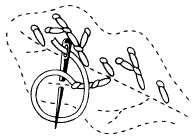Monday, May 7, 2007
Smyrna Stitch
known as the double cross stitch.
It forms a good depiction of the eight Sabbats in the Wheel of the Year.
Bring needle from back to front at odd numbers and enter fabric at even numbers.
All these Type os Sticthes look good.
For larger stars, finish with a tiny stitch across the center to prevent snagging
Basque knot
They can also be worked as a textured line, as they can be easily worked joined together. The line produced is well defined as it is knotted.
Basque knot is similar to Palestrina. The main difference, as you can see from the illustrations you work the stitch from right to left, along a line instead of left to right.
The stitch is worked in the same manner as Palestrina stitch only work the stitch from right to left, along a line instead of left to right. Also instead of moving diagonally behind the fabric you move vertically.

Interlaced Running Stitch
To work this stitch simply pass the needle over and under the fabric to create a line of running stitch. Lace or thread the stitches with a contrasting colour or weight thread.

Thursday, May 3, 2007
Colonial knot

To work Colonial knot stitch, bring your thread up through the fabric. I hold the thread in my left hand and with the thread loose place the needle to the right of the thread with the needle pointing away from you. Take the thread under the needle and then over the needle to form a figure 8. This can be done in a hooking action by turning anti-clockwise the needle 180 degrees.
Take the needle to the back of the fabric close to where it first came out. Before you pull it through make sure the loop is snug around the shaft of the needle
Candlewicking
Candlewicking is a form of surface embroidery that traditionally uses an unbleached cotton thread on a piece of unbleached muslin. It gets its name from the nature of the thread, which very much resembles the wick used in a candle. Motifs are created using a variety of knots and satin stiches. Subject matter is usually taken from nature, flowers, insects, etc. Other traditional motifs resemble PA Dutch or colonial designs. Modern designs include colored floss embroidery with the traditional white on white stitching.
Candlewicking has its origins in american history as new settlers sought to decorate their new homes with minimal supplies. The dust was easily washed from the fabric and able to endure significant wear.
Candlewicking is most commonly used as a cushion cover.
Berwick stitch

This needlework stitch is worked from left to right sewing over two imaginary lines.
Bring the thread out on the lower line, insert the needle in position in the upper line making a straight downward motion and then wrap a loop of thread around the needle point. Pull the needle through the fabric to form a loop. Tighten the knot slightly before moving to the next stitch.
Berwick stitch is equally effective with the knotted edge on the inside or outside of the curve.
In the case of using berwick stitch as an decorative embellishment on crazy quilting a more decorative line can be created with the use of beads, and a detached chain, or French knots sewn at the top of each spine.
The length and spacing of the spines can create ornate patterns and effects. This build up of patterns using the texture of the ridge at the base of the spine is also very effective in forms of counted thread and drawn needlework
Coral stitch, German knot stitch, knotted stitch, beaded stitch

Coral stitch is an old embroidery stitch which creates a line that looks like a row of knots and is used for outlines and follows a curved detail well. Coral stitch is frequently found in seventeenth and eighteenth century English crewel work. It is also a very useful stitch for twiggy bits in a floral design. It can also be used to create a knotted filling with the knots form a secondary pattern across the filling.
Coral stitch is worked from right to left. To work bring the thread up from the back of the fabric and hold it loosely on the surface of the fabric with your thumb. Insert the needle at a right angle, above the line to be worked and bring it out just below the line to be worked. Pull the needle through the fabric and over the thread to from a knot.
Coral stitch can be varied by altering the angle of the needle as it passes through the fabric, and by altering the spacing of the knots along the row. The effect created is also altered by the weight and twist of the thread used.

